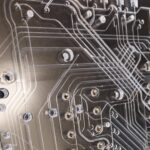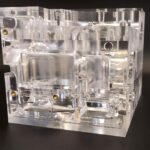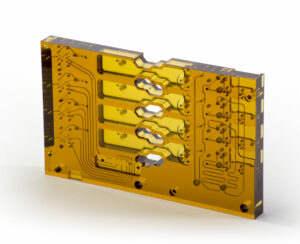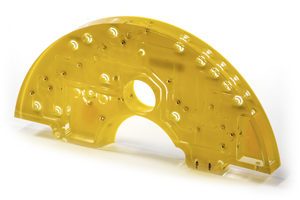Fluidic Manifold Types
There are three main types of fluidic manifolds Carville manufacture for liquid and gas solutions.
 High Accuracy Diffusion bonded (HADB) manifolds
High Accuracy Diffusion bonded (HADB) manifolds
Carville’s diffusion bonding processes, produces highly accurate and repeatable manifolds, often referred to as a “PCB for Fluids”. These provide the most flexible design options with multiple layers and sub-systems in a single component. Visit our Diffusion Bonding page for more details. Typical uses include liquid handling, sample processing, microfluidics, medical systems and pneumatic manifolds.
Solvent Bonded manifolds
 Fluidic manifolds with larger channels, chambers and features that do not require the high accuracy of diffusion bonding, can be manufactured by solvent bonding. The process involves treating the machined surfaces with a specific liquid solvent and then compressing them together to form the bond. Although not as strong and seamless as diffusion bonding, it is often suitable for larger, bulkier applications.
Fluidic manifolds with larger channels, chambers and features that do not require the high accuracy of diffusion bonding, can be manufactured by solvent bonding. The process involves treating the machined surfaces with a specific liquid solvent and then compressing them together to form the bond. Although not as strong and seamless as diffusion bonding, it is often suitable for larger, bulkier applications.
CNC Machined/Cross-drilled manifolds
For simple manifolds, where space is not at such a premium and fluid paths are not complex, a good option is cross drilled manifolds, where solvent bonded plugs are used to block dead end channels.
Material Selection
 For diffusion bonded manifolds, the two material choices are Acrylic PMMA (Plexiglas, Perspex, Lucite) or Ultem (PolyEtherimide PEI). If the application is relatively low temperature (usually less than 70 degrees centigrade) and there are no aggressive chemicals involved, PMMA is the best choice for cost and transparency. For higher temperatures (up to around 170 degrees centigrade) or aggressive chemicals, Ultem is recommended. Although Ultem is less transparent, with vapour polishing and thinner wall sections, a significant degree of transparency can be achieved. It may also be necessary to research or conduct chemical compatibility with the application fluids as PMMA can affect some specific biological processes.
For diffusion bonded manifolds, the two material choices are Acrylic PMMA (Plexiglas, Perspex, Lucite) or Ultem (PolyEtherimide PEI). If the application is relatively low temperature (usually less than 70 degrees centigrade) and there are no aggressive chemicals involved, PMMA is the best choice for cost and transparency. For higher temperatures (up to around 170 degrees centigrade) or aggressive chemicals, Ultem is recommended. Although Ultem is less transparent, with vapour polishing and thinner wall sections, a significant degree of transparency can be achieved. It may also be necessary to research or conduct chemical compatibility with the application fluids as PMMA can affect some specific biological processes.

One advantage of PMMA is that it can come in any colour you like, and you can diffusion bond different colours together, which can be useful for contrast or for corporate identity colours.
Diffusion Bonded Fluidic Manifold Design Options
When considering the design aspects of diffusion bonded plastic manifolds, there are several key features to determine.
Channel cross-section shape and size
Machining in just one layer to be capped with the plain second layer is the most cost effective and dimensionally stable approach. Typical shapes include “D” cross-sections as well as half round or flat, rectangular sections. Widths and depths down to 0.15mm can be achieved with this method for microfluidic applications. Full round cross-sections can be achieved by machining into both layers and matching these in bonding which Carville can do with a high degree of precision, but there are limits on smaller sizes less than 0.5mm diameter. The channel depths, widths and profiles can be varied along the channel if required to provide restrictions or expansions.
Channel spacing
We generally recommend spacing of two channel widths between each channel to assure adequate bonding surfaces.
Components bonded in manifolds
Carville can bond in various types of components within the manifold. These include electrical contacts, filters, flexible membranes and registration parts for medical phantoms such as stainless-steel balls or aluminium foils.
Bonded Chambers
The diffusion bonding process allows chambers with specific volumes and profiles to be incorporated within the manifold. These are used for such things as liquid reservoirs, reference volumes, mixing chambers and vacuum reservoirs. These avoid the need to add these as external components.
Multiple layers
Manufacturing fluidic manifolds with up to 9 layers has been achieved, but most applications can be accomplished with 3 or 4 layers. Carville can support the design process to minimize the number of layers and help guide which features are best located in certain areas.
Carville Development Support
With a wealth of experience in manifold design, development and manufacture built up over the last 45 years, Carville provide unparalleled support to clients for their design challenges. Ranging from clean sheet designs to optimising for manufacture, we are here to assist. View our Product Development page for more details or get in touch.



